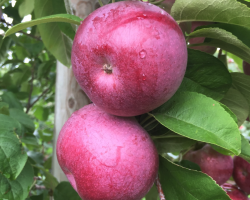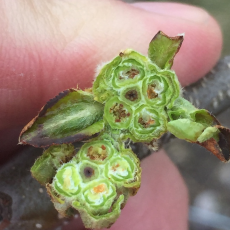Location, location, location. Apparently, this factor for success applies to both real estate and apple trees.
Considering the many challenges that fruit tree growers faced during the summer of 2016 with a decimated peach crop and extended drought, at least there is good news for apple aficionados. Jon Clements, UMass Extension educator and fruit specialist, keeps a close watch on orchards across the state. He said, “The overall crop in Massachusetts is down about 20% from average, but it varies widely from orchard to orchard. This is likely the result of three factors: there was a bumper crop in 2015 and it is not unusual to come back with a lighter crop following the year of a heavy crop; there was a hard freeze in early April when the flower buds were starting to push green-tip which resulted in some damage to the flower/fruit buds (very location-dependent); and, although undocumented at this point, in some orchards, smaller apples from the drought is going to mean reduced yield.”
The severe summer-long drought has affected some orchards in the state, but a bigger impact in determining success this summer was the ability to irrigate apple trees. Where irrigation was available, the drought was largely a non-issue, although the time and energy spent to irrigate (maintaining and running the system) is substantial.
Regarding drought susceptibility among varieties of apples, Clements said there was not much difference. However, there was noticeable damage to apples as a result of the early April freeze. McIntosh and Cortlands fared worse than Honeycrisp and Macouns, as a rule. But again, there were big differences in location: the crop in the western part of Massachusetts was generally hit lighter than it was in eastern Massachusetts. Still, there are plenty of local apples in both eastern and western parts of the state.
As of late September, there has been no documentation about the loss of income for farmers with smaller apple yields. The loss of the peach crop this summer is more problematic in terms of orchard income. The bottom line is that there are still plenty of apples out there. It may not be the best year, but farmers expect some ups and downs and typically bank the extra income from good years to make it through the not-so-good years. It's called risk management.
Consumers should have no problem finding local apples in the short-to mid-term. Honeycrisp set a nice crop of apples and have already been harvested. McIntosh apples are peaking and in some cases there is a very good supply. However, some orchards have less than an optimal crop. What does Clements advise? “Be sure to get out there and buy your apples sooner than later. Or you could also pick-your-own because, as we all know, the apple never falls far from the tree.”

